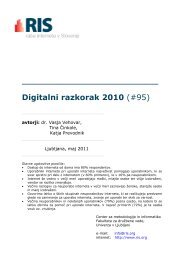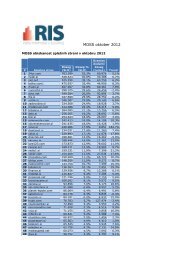Q1 1995 Q3 Q1 1996 Q3 Q1 1997 Q3 Q1 1998 Q3 Q1 1998 Q3 Q1 2000 Q3 Q1 2001 Q3 Q1 2002 Q3 Q1 2003 Q3 Q1 2004 Q3 Q1 2005 Q3 Possible Futures <strong>of</strong> IT Practitioner employment in <strong>the</strong> United Kingdom Figure E-9 shows four scenarios for <strong>the</strong> development <strong>of</strong> <strong>the</strong> size <strong>of</strong> <strong>the</strong> IT Practitioner workforce in <strong>the</strong> United Kingdom, based on <strong>the</strong> Eurostat totals for Computing Pr<strong>of</strong>essionals (ISCO 213) (<strong>the</strong> UK has submitted no data for Computer Associate Pr<strong>of</strong>essionals (ISCO 312*)), based on assumptions <strong>of</strong> employment growth at 2% p.a., 5% p.a., 10% p.a. and 15% p.a., subject to <strong>the</strong> initial trough. Table E-1 shows, for <strong>the</strong> four scenarios given, <strong>the</strong> Total (net) new supply <strong>of</strong> skilled manpower that would be required to sustain that level <strong>of</strong> employment growth. It is recognized that <strong>the</strong> validity <strong>of</strong> <strong>the</strong> assumptions – in particular about <strong>the</strong> shape <strong>of</strong> <strong>the</strong> initial “trough”, <strong>the</strong> “phasing” in relation to <strong>the</strong> relevant national business cycle, and <strong>the</strong> level <strong>of</strong> replacement demand – would be refined as <strong>the</strong> first step in deeper review analysis at <strong>the</strong> national level. Figure E-9 Recent development <strong>of</strong> British ITP workforce total and Forecast Scenarios (Source: Eurostat holdings <strong>of</strong> EU Member State <strong>Labour</strong> Force <strong>Survey</strong>s: data for ISCO 312) 1,200,000 ISCO 213 Numbers in employment in each Category 1,000,000 800,000 600,000 400,000 200,000 Scenario 1 (2% p.a.) Scenario 2 (5% p.a.) Scenario 3 (10% p.a.) Scenario 4 (15% p.a.) 0 Year/Quarter N.B. Average employment growth over previous 5 years was 12.9%; most recent annual employment increase was 2.5% * because, as for Ireland, <strong>the</strong> main national IT Practitioner category included workers both with and without degrees 138 | C E P I S I.T. PRACTITIONER SKILLS IN EUROPE | Annex E
Table E-1 Development Scenarios for IT Practitioners in <strong>the</strong> U.K. Net supply estimation for each Scenario (estimates have not been rounded) Scenario Starying Point: Year/ Quarter 2002 Q2 Scenario 1: initial trough +2% Forecast for total in employment Annual New Supply Requirement Scenario 2: initial trough +5% Forecast for total in employment Annual New Supply Requirement Scenario 3: initial trough +10% Forecast for total in employment Annual New Supply Requirement Scenario 4: initial trough +15% Forecast for total in employment 485,066 485,966 485,966 485,966 Annual New Supply Requirement 2000-2001: 2001 Q2 465,674 477,728 469,479 524,275 Growth Demand -19,392 -8,238 -16,487 38,309 Replacement Demand 11,642 11,943 11,737 13,107 Total (Net) Demand -7,750 3,705 -4,750 51,416 2001-2002 2002 Q2 412,741 434,386 469,155 523,158 Growth Demand -52,933 -43,342 -324 -1,117 Replacement Demand 10,319 10,860 11,729 13,079 Total (Net) Demand -42,614 -32,482 11,405 11,962 2002-2003 2003 Q2 430,046 464,313 521,161 613,688 Growth Demand 17,305 29,927 52,006 90,530 Replacement Demand 10,751 11,608 13,029 15,342 Total (Net) Demand 28,056 41,535 65,035 105,872 2003-2004 2004 Q2 505,877 560,324 653,613 812,746 Growth Demand 75,831 96,011 132,452 199,058 Replacement Demand 12,647 14,008 16,340 20,319 Total (Net) Demand 88,478 110,019 148,792 219,377 2004-2005 2002 Q2 534,596 607,462 736,412 966,970 Growth Demand 28,719 47,138 82,799 154,224 Replacement Demand 13,365 15,187 18,410 24,174 Total (Net) Demand 42,084 62,325 101,209 178,398 C E P I S I.T. PRACTITIONER SKILLS IN EUROPE | Annex E | 139
- Page 1 and 2:
Information Technology Practitioner
- Page 3 and 4:
Information Technology Practitioner
- Page 5 and 6:
Preface In spite of an extended per
- Page 7:
Acknowledgements The author has bee
- Page 10 and 11:
Executive Summary The current state
- Page 13:
Table of Contents 1. Introduction .
- Page 17 and 18:
1. Introduction This Study was init
- Page 19:
In its quantitative work, this stud
- Page 22 and 23:
2. Economic Context 2.1 Scale and I
- Page 24 and 25:
2.2 Market Performance Labour marke
- Page 26 and 27:
2.4 Employers’ and Individuals’
- Page 28 and 29:
26 | C E P I S I.T. PRACTITIONER SK
- Page 30 and 31:
3. Policy Context 3.1 Academic and
- Page 32 and 33:
Probably the greatest challenge in
- Page 35 and 36:
Information Technology Practitioner
- Page 37 and 38:
The ISCO classification used for Eu
- Page 39 and 40:
4.2 Recent development of the IT Pr
- Page 41 and 42:
600,000 500,000 400,000 300,000 200
- Page 43 and 44:
4.3 IT Practitioners in Germany The
- Page 45 and 46:
The “Monitoring Informationswirts
- Page 47 and 48:
4.4 IT Practitioners in Ireland The
- Page 49 and 50:
As part of its work, the Expert Gro
- Page 51 and 52:
Table 3: Sub-sectoral structure of
- Page 53 and 54:
From the data gathered for this stu
- Page 55 and 56:
applicants to such courses (as meas
- Page 57 and 58:
• Around one in ten establishment
- Page 59 and 60:
4.7 Some comparisons between the fo
- Page 61 and 62:
Employment Status: Probably the mos
- Page 63 and 64:
Highest Academic Achievement of Com
- Page 65 and 66:
ISCED Levels 0-2: General Education
- Page 67 and 68:
4.8 IT Practitioners in other Membe
- Page 69 and 70:
1.8 1.6 1.2 1 0.6 0.2 Figure 18 Num
- Page 71 and 72:
Recent policy responses to skill sh
- Page 73 and 74:
Information Technology Practitioner
- Page 75 and 76:
The IDC approach is based on estima
- Page 77 and 78:
5.3 Improving Validity of Estimates
- Page 79 and 80:
Q1 Q2 2000 Q3 Q4 Q1 Q2 2001 Q3 Q4 Q
- Page 81 and 82:
Figure 20 Development Scenarios for
- Page 83 and 84:
Information Technology Practitioner
- Page 85 and 86:
6.2 The Need for, and Value of, Mor
- Page 87 and 88:
6.4 Proposed Full Study for all EU
- Page 89 and 90: Information Technology Practitioner
- Page 91: (ii) Education and Training terms i
- Page 95 and 96: Annex A Definitions, Datastructures
- Page 97 and 98: - “Skills Framework for the Infor
- Page 99 and 100: Occupational Frameworks for this St
- Page 101 and 102: NACE Nomenclature generale des Acti
- Page 103 and 104: Section J: Financial intermediation
- Page 105 and 106: ISCO International Standard Occupat
- Page 107 and 108: Limitations: Eurostat Holdings of M
- Page 109 and 110: The occupational classification app
- Page 111 and 112: SOC-90 Categories ISCO-88 Codes 123
- Page 113 and 114: Annex B Analyses of Eurostat Data:
- Page 115 and 116: 120,000 Figure B-2 Age Profiles of
- Page 117 and 118: Numbers employed with ISCED Educati
- Page 119 and 120: Q1 1995 Q3 Q1 1996 Q3 Q1 1997 Q3 Q1
- Page 121 and 122: Annex C Analyses of Eurostat Data:
- Page 123 and 124: Employer Size Distribution of Compu
- Page 125 and 126: Table C-1 Development Scenarios for
- Page 127 and 128: Annex D Analyses of Eurostat Data:
- Page 129 and 130: Numbers in employment in each Categ
- Page 131 and 132: Status of Computing Professionals i
- Page 133 and 134: Table D-1 Development Scenarios for
- Page 135 and 136: Annex E Analyses of Eurostat Data:
- Page 137 and 138: 350,000 Figure E-3 Computing Profes
- Page 139: 25,000 Figure E-7 Status of Computi
- Page 143 and 144: Annex F References and Brief Abstra
- Page 145 and 146: IDC (2000): IDC Study on the ICT sk
- Page 147 and 148: IDC (Milroy, A. and Rajah, P.) 2000
- Page 149 and 150: 2. National Level Work: a. Germany
- Page 151 and 152: ITNTO 1999 “Bugbuster” Final Re
- Page 153: Council of European Professional In

















